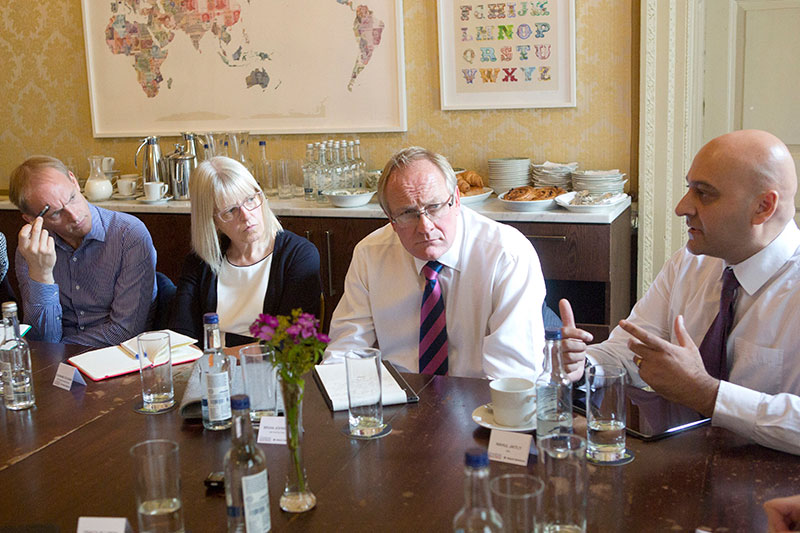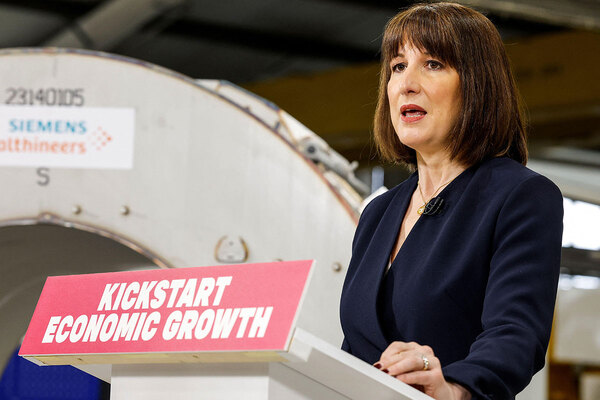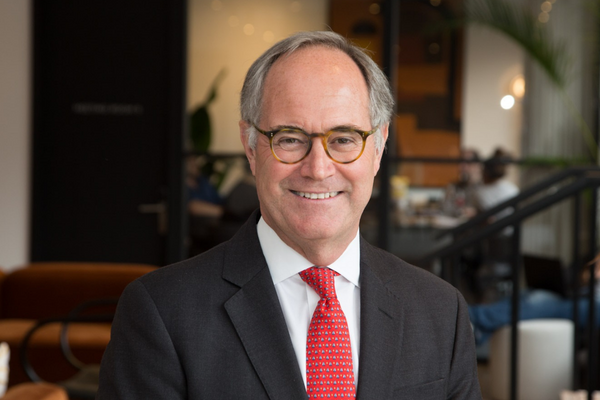Looking ahead to the future of the sector
Inside Housing and Hitachi Solutions brought together sector leaders to discuss what kind of future housing associations should be planning for
In association with:

What does the future hold for housing associations? This is the question that exercises the minds of the sector’s senior players as they look to plan ahead.
In the past 10 years there has already been much change, with many managing a growing mix of products such as affordable rent, shared ownership and market sale. Then there’s been the escalating housing crisis, a reduction in grant funding and the Brexit vote. Political attention led to the 1% rent cut that compelled associations to shave costs from their businesses.
What should today’s chief executives and senior managers be planning for, though? What journey will they be taking the sector on? Inside Housing and Hitachi Solutions gathered social housing leaders at the House of St Barnabas in London’s Soho to get their views on housing’s trajectory.
Martin Hilditch, deputy editor of Inside Housing and chair of the session, starts the discussion by asking the panel how the current political environment will shape the future – or the extent to which it should.
Susanne Coleman, programme manager – transformation at 28,000-home Southern Housing Group, says associations need to “keep a watch on risk” due to uncertainty.
But she feels as though social landlords are now in the driving seat in a way they haven’t been previously in terms of the relationship with government, thanks to much of its attention being diverted elsewhere.
“The sector is reaching a point of maturity in its ambition and financial muscle.”
“It feels like there is an open door for us to say ‘this is the agenda and we can provide a lot of the solutions for you’,” she says.
Brian Johnson, former chief executive of 38,000-home Metropolitan, also sees the positives.
“The fact that we’ve got a minority government and Brexit going on at least means that some of the things that have been happening over the past five years that were pulling apart parts of the housing association sector have stopped,” he says.
But he admits there are some political loose ends that still need tying up, such as around rent-setting.
“That’s going to be tough because of this minority government.”
The panel agrees that risk will start to become a bigger issue for associations as they increasingly diversify, especially if another housing downturn happens.
“We’re now cyclical,” says Brendan Sarsfield, chief executive of 55,000-home Peabody, which recently merged with Family Mosaic.
“Consumer-focused co-production is a really important driver of innovative new models.”
“Sales is a big risk and a big reward for us all now. And managing that balance is really critical,” he says.
If another downturn were to happen, Mr Sarsfield doesn’t expect any of the ‘big players’ in the sector to end up in trouble, but it would put a dampener on housing association ambition.
“What it would do is stop us developing. Part of the debate now should be: if and when that happens, how should we sustain development?”
But the future of the sector isn’t solely in the hands of developing associations. Tracy Allison, deputy chief executive and group director of change and strategy at 48,000-home Hyde, points to the challenge of an increasingly polarised sector.
“What’s the driver for the sector – is it about providing more homes? A lot of the smaller, more specialised housing associations don’t see that as being their driver, it’s more about maintaining the service and the status quo they have,” she says.
Rahul Jaitly, chief information officer at 90,000-home L&Q, says the juxtaposition between more traditional business models and some of the complex ecosystems that are emerging will be a growing challenge regulators will have to learn to adapt to.
“[There was an] expectation that everyone who received that service should be grateful for what they were receiving.”
“If you think about regulations that are happening in other sectors, such as the music industry, as they’ve gone through that digital disruption and created new models the hereditary bodies took some time and effort to adjust,” he explains.
Cher Lewney, head of industry – housing at Hitachi Solutions, thinks the future could involve more partnership working. “One of the models I find interesting is the concept of constitutional partnerships in Scotland. There are a ton of housing associations up there and some of them are really tiny but because they’re really wedded in the community they don’t particularly want to give up their name or identity, so they’re going into constitutional partnerships with larger organisations, taking some of the efficiencies that come across through that type of model.”
There is increasing commercialisation throughout the sector, as evidenced in the diversification in the activities of many housing associations. But, as the regulator has warned, there is a danger that organisations could get stranded in deep water if they don’t take a measured approach.
But the panel agrees that social purpose is still very much in the DNA of the sector, even in the face of rapid commercialisation. Mr Sarsfield of Peabody believes that the spirit of social purpose will persevere into the future.
“The sector’s heart is still there and the fact that we’re doing commercial things, everybody knows why and we should just grow up and accept that,” he says.
However he suggests that if associations do stray from the path of social purpose, they “should be judged as if they are private sector”.
As times change and technology improves, there is a growing question around how well-placed housing associations are to tackle the changing expectations of customers.
This is an area in which housing can learn from the private sector, says Jane Ashcroft, chief executive of 1,000-home Anchor, which specialises in housing and care for over-55s. She cites the organisation’s care arm’s move into the private payer market as an example of an injection of private sector thinking improving its customer offering.
“This sort of consumer-focused co-production is a really important driver of innovative new models,” she says. “Then the commissioned services can follow on with good practice from that.”
Paul Hackett, chief executive of 44,000-home Optivo, backs up the view that involving customers is integral to the delivery of better services.
“We have to find a way to put subsidy into homes because people can’t afford them.”
He says Optivo has been working to develop a series of apps that underpin its mobile working model, which customers have been heavily involved in the development of.
“The starting point for creating those apps is to process and map each activity and if you do that with customers it’s fascinating to see which parts of that process they believe add value and don’t add value, and that has really helped us to improve the process,” he explains.
Question of trust
Ms Lewney of Hitachi agrees that meaningful consultation is important. But in her experience, although there were a lot of engagement mechanisms with tenants when she first started working in the sector 11 years ago, there was almost an “expectation that everyone who received that service should be grateful for what they were receiving and therefore they just needed to take the quality of it as it was”.
Has that view changed now? Ms Coleman of Southern Housing Group says: “[The approach] has changed dramatically. I wouldn’t suggest we’re perfect at it, but it’s dramatically improved from years ago.”
The way housing associations engage with their customers has come sharply into focus recently, following the tragic fire at Grenfell Tower in June. Mr Hackett of Optivo says: “It’s inconceivable that it’s not going to fundamentally shift the dial on how we do things going forward.”
“Sales is a big risk and a big reward for us now. Managing that balance is really critical.”
Ms Ashcroft of Anchor says that the need to maintain or win back the trust of customers will be a continuing theme for associations – and that this has been a theme for many organisations and institutions in today’s world.
“Lots of institutions which were traditionally trusted have been through that process of that trust being taken away and the whole concept of who you trust and how you trust them has really changed,” she says.
Grenfell will see ongoing scrutiny of the sector and the way tenants are consulted about decisions that will affect them. For instance, Julian Chun, director of transition at 30,000-home Vivid, says associations will need to do more to assuage customer fears that their value for money programmes aren’t resulting in corners being cut.
“There’s a real danger if we don’t stand firm to say our value for money agenda is not about driving down quality and the complexity of what we do, it’s more about doing it better and doing it more efficiently,” he says.
Vital issues, then, that will shape landlord/tenant relationships for the foreseeable future. But Mr Johnson, formerly of Metropolitan, argues that the fundamental challenges of the sector aren’t likely to change in the near future.
“Land costs money, you have to get planning permission and we have to find a way to put subsidy into homes because people can’t afford them,” he says.
“We’re acting as disruptors because we have that charitable ambition.”
For Mr Jaitly of L&Q, it’s more about how housing associations are set to bring about change in other sectors.
“We are emerging into other areas that are already established sectors – property management, estate agency, construction etc. We’re acting as disruptors to a certain extent because we have that charitable ambition to create homes,” he says.
Mr Hackett rounds off with his own spot of future-gazing. “The sector is reaching a point of maturity in both its ambition and its financial muscle,” he says.
“This is the beginning of a process; if we look 10 to 15 years downstream there will have been a lot of this kind of activity which gives the opportunity for greater diversification, greater control over the supply chain, greater efficiency and the opportunity to disrupt private sector providers.”
Photography by Belinda Lawley
Participants
- Tracy Allison, deputy chief executive, Hyde
- Jane Ashcroft, chief executive, Anchor
- Julian Chun, director of transition, Vivid
- Susanne Coleman, programme manager – transformation, Southern Housing Group
- Paul Hackett, chief executive, Optivo
- Rahul Jaitly, chief information officer, L&Q
- Brian Johnson, former chief executive, Metropolitan
- Cher Lewney, head of industry – housing, Hitachi Solutions
- Brendan Sarsfield, chief executive, Peabody













